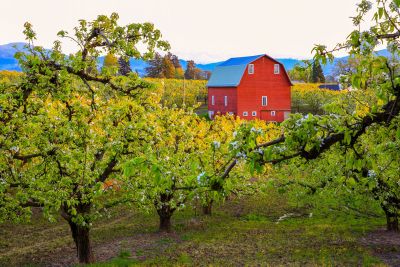Apples are a big export and likely the most common fruit trees grown in Washington State, but fruit trees for the Pacific Northwest range from apples to kiwis to figs in some areas.
Growing Fruit Trees in the Northwest
The Pacific Northwest borders the Pacific Ocean, the Rocky Mountains, the north coast of California, and up into southeastern Alaska. This means the climate varies somewhat from area to area, so not every fruit tree suited for one region of the Northwest is suited to another. USDA zones 6-7a are next to the mountains and are the coldest areas of the Pacific Northwest. This means that tender fruits, such as kiwis and figs, shouldn’t be attempted unless you have a greenhouse. Avoid late ripening and early blooming varieties of fruit trees for this region. Zones 7-8 through the Oregon Coast Range are milder than those in the zone above. This means that options for fruit trees in this area are broader. That said, some areas of zones 7-8 have harsher winters so tender fruit should be grown in a greenhouse or heavily protected. Other areas of zone 7-8 have warmer summers, lower rainfall, and mild winters, which means that fruit that takes longer to ripen can be grown here. Kiwi, figs, persimmons and long season grapes, peaches, apricots, and plums will thrive. USDA zones 8-9 are near the coast which, although spared from the cold weather and extreme frost, has its own challenges. The heavy rain, fog, and wind can create fungal issues. The Puget Sound region, however, is inland farther and is an excellent area for fruit trees. Apricots, Asian pears, plums, and other fruit are suited to this area as are late grapes, figs, and kiwis. USDA zones 8-9 can also be found in the shadow of the Olympic Mountains where overall temps are higher but summers are cooler than the Puget Sound which means varieties of fruit that ripen late should be avoided. That said, tender fruit such as fig and kiwi usually overwinter. In the Rogue River Valley (zones 8-7) summer temperatures warm sufficiently to ripen many types of fruit. Apples, peaches, pears, plums, and cherries thrive but avoid late-ripening varieties. Kiwis and other tender subtropicals can be grown as well. This area is extremely dry so irrigation is needed. Zones 8-9 along the coast of California down to San Francisco is quite mild. Most fruit will grow here including the tender subtropicals.
Choosing Fruit Trees for Pacific Northwest Regions
Since there are so many microclimates within these regions, choosing fruit trees in the Northwest can be challenging. Go to your local nursery and see what they have. They will generally be selling cultivars that are suited to your region. Also, ask your local extension office for recommendations. There are thousands of apple varieties, again one of the most common fruit trees in Washington. Before you buy decide what you are looking for in the flavor of the apple, what your purpose is for the fruit (canning, eating fresh, drying, juicing), and consider disease-resistant varieties. Do you want a dwarf, semi-dwarf, or what? The same advice goes for any other fruit tree you are buying. Look for bare-root trees, as they cost less and you can easily see how healthy the root system looks. All fruit trees are grafted. The graft looks like a knob. When you plant your tree, be sure to keep the graft union above the level of the soil. Stake newly planted trees to help stabilize them until the roots establish. Do you need a pollinator? Many fruit trees need a buddy to help with pollination. Lastly, if you live in the Pacific Northwest, then you are aware of the wildlife. Deer can decimate trees and birds like cherries as much as you do. Take the time to protect your new fruit trees from wildlife with fencing or netting.
